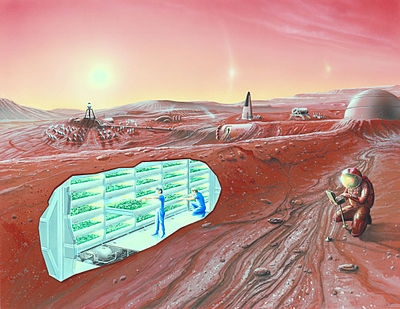Mars is a long ways away, and this is probably premature to say the least, but groups willing to colonise the Red Planet are already forming, some more credible than others:
(PC Mag) — The successful completion of the SpaceX mission to the International Space Station, as well as the ongoing developments at Virgin Galactic have apparently set off a trend. Despite the enormous difficulty and expense related to space travel, a Dutch group has announced plans to set up a small living station on Mars by 2023.
The group effort, dubbed Mars One, is led by Bas Lansdorp, a researcher from the Netherlands with a Masters in Science from Delft University of Technology. The plan is to send a communications satellite to the planet by 2016 and after several stages finally land humans on Mars for permanent settlement in 2023.
I’m an optimistic guy when to comes to space travel and exploration. But even I see Martian colonies as 50 years away before we can even begin. Plus a lot of things would have to go right to make that date, in my opinion.
And if that ever does happen, the ideal colonist wouldn’t necessarily be a big athletic European. If I was going to pick a group based solely on physical characteristics, sans genetic engineering, it would be itty-bitty Ecuadorian or Tibetan natives, predominantly female simply because they’re smaller on average. Tiny people with dark adapted to UV, and big lungs for thin, cold dry air, and a tradition of minimalist lifestyles would be the ticket.


I’d do anything …
I can’t stories like this. I get to dreamy eyed.
Thanks for that. A lot of science fiction and space enthusiast keep picturing a hunked out James Tiberius Kirk when they think space explorer ignoring the obvious issues of getting along with others and food in take.
It’s not just food intake but the size of quarters and everything else. Try visiting an historic colonial house in the US (mind your head). The submarine service also has a maximum height limit for the same reason. Since the scale increases geometrically (the ratio of the heights cubed) it takes 1.728 times the space to provide equivalent accommodations for a six foot guy like me compared to someone five feet tall.
I suppose the question is what the purpose of the colony is. If it’s for travel and tourism we would probably have to bite the bullet for luxurious accommodations. If it’s just to get brains and hands on the ground then we can get a lot more for our money with smaller bodies.
I also see this as premature.
I think it makes more sense to work on moon bases & near earth asteroids for the next few decades. The confirmation of volatiles like water near the lunar poles takes away what had been one of Mars’ major pluses over the moon for near term activity, while leaving the moon’s major advantage of being close.
Meanwhile this discovery that earth often temporarily captures NEAs, makes the investigation & use of NEAs easier than previously thought.
It’s better to get some experience with living on another body relatively close by, where emergency supplies can be delivered in days rather than months at best.
I applaud SpaceXs success. I also applauded the NASA programs. I’m old enough to have experienced the first round of pronouncements of colonies soon to come on Mars. That was in the late 60s. Many of the current round seem to be using art work recycled from the 60s.
SpaceXs latest mission id a step in the right direction. And a damn sight better news than to recent moribund NASA efforts. But it is just one step of many. Two facts have to be kept in mind:
First, SpaceX is financed, catered to, and highly dependent upon NASA. Like so many other fledgling businesses it is government that provides the permissive and protected environment and infrastructure that allows the tender young enterprises to mature.
Second, the generally accepted estimate of cost of moving cargo to orbit for NASA is $10,000 per pound. Given a disclosed cost of about $50 million, and the mass delivered, the rough estimate of cost is $40,000 per pound. The cargo delivery contract that NASA will sign with SpaceX will have, for the time being, will have taxpayers paying the extra cost over and above what it would cost NASA to do on its own.
Given time SpaceX, and the other fledgling space contractors may be able to stand on their own and we may see a reduction of costs to the taxpayers and an increase in both responsiveness and performance. But that remains a possibility contingent upon both generous taxpayer support and tolerance of increased short and mid-term costs.
jimbaerg–thanks for including that link. It is
a good day when I learn something new, & I had never
heard of horseshoe orbits.